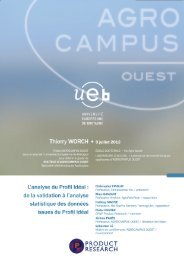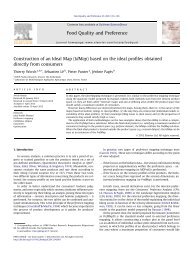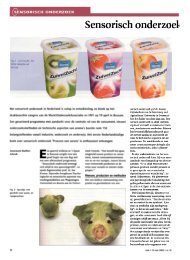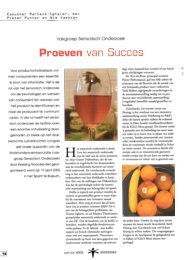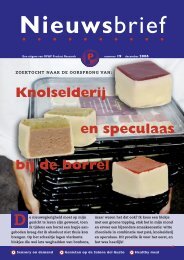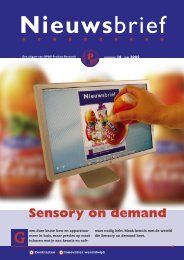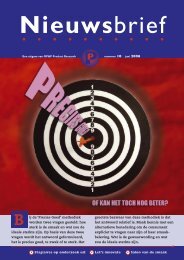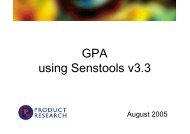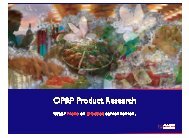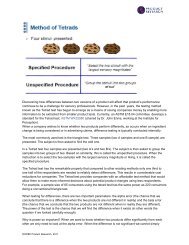Generalised Procrustes Analysis - OP&P Product Research
Generalised Procrustes Analysis - OP&P Product Research
Generalised Procrustes Analysis - OP&P Product Research
You also want an ePaper? Increase the reach of your titles
YUMPU automatically turns print PDFs into web optimized ePapers that Google loves.
<strong>Generalised</strong> <strong>Procrustes</strong><br />
<strong>Analysis</strong><br />
applications in sensory evaluation and<br />
instrumental analysis
GPA course, ©OP&P <strong>Product</strong> <strong>Research</strong>,<br />
Utrecht<br />
Senstools ® is an OP&P trademark<br />
It is not allowed to copy or use parts of this<br />
course without proper reference to OP&P<br />
Utrecht, 2004<br />
<strong>Procrustes</strong> principles
• Introduction<br />
Today’s program<br />
• The <strong>Procrustes</strong> principles<br />
• Different data, different analysis<br />
• Some ‘sensory’ examples<br />
• Examples of FCP data<br />
• A hands-on demonstration<br />
• Discussion<br />
Program
• The history of GPA<br />
Introduction<br />
• Description of the Senstools package:<br />
functionality and tools<br />
• GPA routine in Senstools<br />
Introduction
History of GPA<br />
• 1952 (Green), 1962 (Hurley & Cattel): onesided<br />
orthogonal <strong>Procrustes</strong> rotation<br />
• 1968 (Schönemann), 1970 (Schönemann &<br />
Carroll): two-sided orthogonal <strong>Procrustes</strong><br />
rotation with scaling<br />
• 1971 (Wingersky): more than two<br />
configurations<br />
Introduction: history GPA
History: continued<br />
• 1975 (Gower): generalised <strong>Procrustes</strong> with<br />
scaling factor and Anova (Psychometrika)<br />
• 1982-1986: practical application in sensory<br />
by Tony Williams, Gillian Arnold, Steve<br />
Langron and others<br />
• until 1989 GPA was only available as macro<br />
in SAS or Genstat<br />
Introduction: history GPA
History: continued<br />
• 1989: OP&P wrote the first PC routine for<br />
GPA in APL (<strong>Procrustes</strong>-PC)<br />
• 1993: the program was written in C<br />
• 1995: Senstools-for-Windows v1.0 was<br />
released<br />
• 2000: Senstools v3.0 was released<br />
Introduction: history GPA
Time needed to solve a simple<br />
problem<br />
20 subjects - 8 products - 20 attributes<br />
1989 13 hours<br />
1993 25 minutes<br />
1995 55 seconds<br />
2000 0,6 seconds<br />
Introduction: history GPA
Description of Senstools package<br />
Data analysis tool for sensory professionals<br />
Uni- and multivariate statistics<br />
• descriptive statistics<br />
• analysis of variance<br />
• assessor statistics and concordance<br />
Introduction: Senstools package
• PCA<br />
Description continued….<br />
• Generalized <strong>Procrustes</strong> <strong>Analysis</strong><br />
• MDPref<br />
• Latent Variable Cluster analysis<br />
• Graphics<br />
Introduction: Senstools package
GPA routine in Senstools<br />
Introduction: Senstools package
• Introduction<br />
Today’s program<br />
• The <strong>Procrustes</strong> principles<br />
• Different data, different analysis<br />
• Some ‘sensory’ examples<br />
• Examples of FCP data<br />
• A hands-on demonstration<br />
• Discussion<br />
Program
<strong>Procrustes</strong><br />
• <strong>Procrustes</strong> was a character of Greek myth.<br />
An innkeeper who plied his trade in Attica,<br />
he put his victims on an iron bed. If they<br />
were longer than the bed, he cut off their<br />
feet. If they were shorter, he stretched<br />
them……..<br />
<strong>Procrustes</strong> principles
More or less like this….<br />
<strong>Procrustes</strong> principles
The Procrustean principles<br />
Make the configurations fit each other:<br />
• do this by moving them to a common origin<br />
• stretch or shrink each configuration in order<br />
to make it fit as good as possible<br />
• if needed, flip them around<br />
<strong>Procrustes</strong> principles
in summary:……..<br />
• <strong>Procrustes</strong> only allows ‘rigid-body’ transformations<br />
to the datasets<br />
• these transormations respect the relative<br />
distances between objects<br />
<strong>Procrustes</strong> principles
Modern Proctustes<br />
• consider K configurations of n objects in pdimensional<br />
spaces<br />
• how can we represent the K configurations<br />
in a common space while minimizing the<br />
goodness of fit criterion?<br />
• we do this with the aid of 3 transformations<br />
<strong>Procrustes</strong> principles
translation<br />
The first transformation<br />
• move the centroids of each configuration to<br />
a common origin<br />
<strong>Procrustes</strong> principles
3 sets (A,B,C)<br />
3 products (1,2,3)<br />
2 attributes<br />
A2<br />
A1<br />
Set A<br />
B1<br />
<strong>Procrustes</strong> principles<br />
C1<br />
B2<br />
A3<br />
Set B<br />
B3<br />
Set C<br />
C2<br />
C3
sets translated to<br />
common origin<br />
C1<br />
<strong>Procrustes</strong> principles<br />
A2<br />
B1<br />
A1<br />
C2<br />
B2<br />
B3<br />
A3<br />
C3
The second transformation<br />
isotropic scaling<br />
• shrink or stretch each configuration<br />
isotropically to make them as similar as<br />
possible<br />
<strong>Procrustes</strong> principles
sets isotropically<br />
scaled<br />
B1<br />
C1<br />
A2<br />
<strong>Procrustes</strong> principles<br />
A1<br />
C2<br />
B2<br />
A3<br />
B3<br />
C3
The third transformation<br />
rotation/reflection<br />
• turn or flip the configurations<br />
<strong>Procrustes</strong> principles
The notation and algorithm<br />
<strong>Procrustes</strong> principles
1.1 Notation<br />
T Transformation matrix, in GPA context a rotation matrix: T'T’=T’T'=I<br />
X a 3-way or K-sets datamatrix of order K×N×M (3-way, K individual data sets of N rows×M<br />
colums) or K×N×Mk (K-sets)<br />
X the group average matrix K<br />
− K<br />
1<br />
k=<br />
1<br />
Xk a group average matrix excluding Xk from the average:<br />
X<br />
k<br />
T<br />
k<br />
X<br />
k<br />
−1<br />
K<br />
Xi<br />
i<br />
i=<br />
1,<br />
i≠k<br />
= ( K −1)<br />
T<br />
Y a 2-way matrix of order (N×J), of design variables and/or physical/chemical variables.<br />
1.2 Algorithm<br />
The GPA method was first described by Gower (1975), and some modifications are found in Ten<br />
Berge (1977). We will follow the algorithm as basically provided by the latter. It is convenient to<br />
interpret the algorithm to consist of three main parts (see Fout! Verwijzingsbron niet gevonden.):<br />
1. Pre-processing and initialisation<br />
2. Procrustean iterations, possibly including isotropic scaling<br />
3. Post processing and presentation of results<br />
All three parts are potentially subject to adaptation due to our inclusion of a PLSR step to allow for<br />
an extra Y matrix to exert its influence. For the moment we will envision a PLSR step to be<br />
included in step 2 above. The original GPA algorithm according to Ten Berge (1977) is as follows,<br />
ignoring for the moment pre- and post-processing steps, which are not part of the GPA process<br />
proper.<br />
Initialisation of the necessary parameters.<br />
For k=1, …, K rotate Xk to k X by T = QP′<br />
, where P and Q come from the SVD<br />
′ k k<br />
X X = P Q′<br />
Evaluate the loss function: σ =<br />
s<br />
K<br />
k=<br />
1<br />
X T − X<br />
k<br />
k<br />
<strong>Procrustes</strong> principles<br />
PRE-PROCESSING<br />
Translation<br />
PCA on long individual sets<br />
Scaling the total variation<br />
INITIALISATION<br />
Initializing rotation matrices on I<br />
Initializing scaling factors on 1<br />
ROTATION<br />
set loop k=1,…,K<br />
SCALING<br />
set loop k=1,...,K<br />
CONVERGENCE TEST<br />
σ s -σ s-1
Basic principles of GPA<br />
• Use the 3 transformations to make the<br />
individual spaces as similar as possible<br />
• Compute a Group-Average-Space of these<br />
individual spaces<br />
• Compute the difference between the Group<br />
and Individual spaces (the residuals)<br />
• Minimizes the total residual by applying the<br />
3 transformations<br />
<strong>Procrustes</strong> principles
The computations<br />
• GPA performs the transformations on each set<br />
• Individual configurations are averaged when<br />
they are as alike as possible<br />
• the resulting high-dimensional space is reduced<br />
by means of PCA to a lower dimensionality<br />
• the total variance in the data is partitioned over<br />
sets, objects or dimensions<br />
<strong>Procrustes</strong> principles
<strong>Procrustes</strong>-Anova (Panova)<br />
• The total variance (V T ) consists of consensus<br />
variance (V C ) and within variance (V W )<br />
• the consensus variance (V C ) consists of two<br />
parts: the part explained by the first Q<br />
dimensions of the consensus space (V I ) and the<br />
part left unexplained (V O , the part associated<br />
with the higher dimensions)<br />
<strong>Procrustes</strong> principles
The <strong>Procrustes</strong>-Anova (Gower)<br />
Zero padding assym. data<br />
and centering<br />
V T<br />
Scaling and rotation<br />
Averaging individual spaces<br />
V C=(V T-V W)<br />
PCA to lower dim. space<br />
V I=(V T-V W -V O)<br />
<strong>Procrustes</strong> principles<br />
Loss V W<br />
Loss V O<br />
Group<br />
average<br />
space
Panova output in Senstools<br />
• The total, consensus and residual variance is<br />
shown as it is distributed over sets, objects and<br />
dimensions<br />
• high consensus variance for objects indicates<br />
agreement about the position of the objects by<br />
the assessors<br />
• high residual variance for assessors indicate<br />
that the assessor does not agree with the others<br />
<strong>Procrustes</strong> principles
Significance of the results ?<br />
• in contrast with PCA, the amount of variance<br />
explained in itself does not give an indication<br />
for the significance or fit of the final solution<br />
• a permutation test is used to estimate the odds<br />
that a ‘random’ dataset would give a similar<br />
percentage consensus variance<br />
<strong>Procrustes</strong> principles
The <strong>Procrustes</strong> permutation test<br />
• take the original dataset, permute the rows<br />
within each set and run an analysis<br />
• repeat this 50 times<br />
• the 90th and 98th percentile of the percentage<br />
of consensus variance from these permuted<br />
sets are compared to the percentage in the<br />
actual dataset<br />
<strong>Procrustes</strong> principles
• Introduction<br />
Today’s program<br />
• The <strong>Procrustes</strong> principles<br />
• Different data, different analysis<br />
• Some ‘sensory’ examples<br />
• Examples of FCP data<br />
• A hands-on demonstration<br />
• Discussion<br />
Program
• 3-mode data<br />
Two basic types of data<br />
– products×assessor×characteristics<br />
– (conventional) profiling<br />
• K-sets data<br />
– products×(assessors×idiosyncratic characteristics)<br />
– ‘free choice’ profiling<br />
Different data
N products<br />
M attributes<br />
3 Mode data<br />
Different data<br />
K assessors<br />
( N × M ) datamatrix X k<br />
for one assessor<br />
3-mode data structure representing Conventional Profiling data: N<br />
products are judged by K assessors using M attributes.
N products<br />
X<br />
1<br />
M 1 attributes<br />
K-sets data<br />
X<br />
2<br />
M 2 attributes<br />
K assessors<br />
X<br />
3<br />
M 3 attributes<br />
Data structure representing Free Choice Profiling data: N products are judged<br />
by K assessors each using M k attributes.<br />
Different data<br />
X<br />
K<br />
M K attributes
Averaging sensory data<br />
• Conventional profiling: we can average and<br />
use PCA to summarize<br />
• FCP: we cannot average, we need GPA<br />
• in case of individual differences, can we<br />
average at all?<br />
Different data
ΣΣ.. results in averaged data set<br />
<strong>Product</strong>s<br />
attributes 1-n<br />
Average<br />
Different data<br />
Analyses:<br />
PCA/Factor<br />
MDS<br />
…...
PCA<br />
• Fit a low dimensional structure that captures<br />
the most variance of the high dimensional<br />
structure<br />
• shows (cor)relations between variables<br />
• shows similarities between objects<br />
• gives fit of dimensions<br />
see Jolliffe, I.T. (1986). Principal Component <strong>Analysis</strong>. Springer-Verlag.<br />
Different data
Correlation matrix<br />
PRED PGREEN MOIST DRYMAT ACID ITHICK KATAC<br />
PRED 1.000<br />
PGREEN 0.921 1.000<br />
MOIST 0.841 0.846 1.000<br />
DRYMAT 0.196 0.098 0.027 1.000<br />
ACID 0.609 0.526 0.502 0.534 1.000<br />
ITHICK 0.224 0.182 0.361 0.327 0.390 1.000<br />
KATAC -0.609 -0.587 -0.669 -0.207 -0.497 -0.301 1.000<br />
Instrumental measurements on 66 apples.<br />
Different data
%VAF<br />
60<br />
50<br />
40<br />
30<br />
20<br />
10<br />
0<br />
55.883<br />
Scree graph<br />
19.286<br />
10.756<br />
Different data<br />
6.834<br />
4.51<br />
1.707<br />
1 2 3 4 5 6 7<br />
Dimension<br />
1.024
dimension 2<br />
0.8<br />
0.6<br />
0.4<br />
0.2<br />
0<br />
-0.2<br />
-0.4<br />
-0.6<br />
Biplot<br />
DRYMAT<br />
ITHICK<br />
ACID<br />
15<br />
18<br />
KATAC<br />
6 30<br />
9<br />
19 7<br />
226<br />
+<br />
35 29 2021 23<br />
22<br />
14 17<br />
24<br />
31<br />
3275<br />
8<br />
2834<br />
12<br />
1 10<br />
25<br />
33<br />
32<br />
13<br />
11 4<br />
PRED<br />
MOIST<br />
16 PGREEN<br />
36<br />
54<br />
63<br />
62<br />
6647<br />
57 5641<br />
64<br />
71<br />
44 58<br />
65<br />
72<br />
69 6042 38<br />
55<br />
5345<br />
59<br />
61<br />
68<br />
48 39 50 51<br />
43 40 67<br />
46<br />
49<br />
70<br />
52<br />
37<br />
-0.8<br />
-0.8 -0.6 -0.4 -0.2 0 0.2 0.4 0.6 0.8<br />
dimension 1
Applications of GPA -1<br />
Why use GPA instead of PCA for conventional<br />
profiling?<br />
• GPA will preserve the individual information:<br />
- information about individual scale-usage<br />
- the relative contribution of individuals to the<br />
group result<br />
- the consensus of individuals with the group<br />
GPA in Sensory
Applications of GPA -2<br />
The special case: non-matching attributes<br />
• GPA is the only way to analyze:<br />
- data from different countries/languages<br />
- free choice profiling data<br />
- in general: K Sets data<br />
GPA in Sensory
Format of free choice data<br />
<strong>Product</strong>s<br />
attributes set 1<br />
Set 1<br />
Set 2<br />
GPA in Sensory<br />
only products are similar<br />
attributes set 2 attributes set 3 ributes set 4<br />
Set 3<br />
Set 4<br />
utes set K<br />
attributes set 5<br />
Set K
<strong>Product</strong>s<br />
Format of K Sets data<br />
chemical data<br />
Chemical<br />
GPA in Sensory<br />
attributes<br />
instrumental data<br />
Instrumental<br />
only products are similar<br />
Sensory
GPA in sensory & consumer<br />
science - 1<br />
GPA in sensory science:<br />
• shows the relationships between products and<br />
attributes<br />
• monitoring panelist performance<br />
• relating sensory data to instrumental or<br />
chemical data<br />
GPA in Sensory
GPA in sensory & consumer<br />
science - 2<br />
GPA in consumer science:<br />
• shows the relationships between products and<br />
attributes<br />
• takes individual differences into account<br />
• corrects for lack of training<br />
GPA in Sensory
Basic assumptions in classical<br />
sensory profiling<br />
• assessors know meaning of attributes<br />
• assessors know meaning of scale<br />
• assessors use scale in consistent manner<br />
Training will provide the necessary skills !<br />
GPA in Sensory
Nevertheless: three possible<br />
• Effects of level<br />
• Effects of range<br />
problems<br />
• Effects of meaning/interpretation<br />
GPA in Sensory
Effects of level<br />
Very weak Very strong<br />
assessor 1<br />
Very weak Very strong<br />
assessor 2<br />
GPA in Sensory
Effects of range<br />
Very weak Very strong<br />
Very weak Very strong<br />
GPA in Sensory
Effects of meaning/interpretation<br />
Very weak sweetness Very strong<br />
Very weak bitterness Very strong<br />
GPA in Sensory
GPA removes the effects of level, range and<br />
interpretation from each individual dataset by<br />
applying 3 transformations:<br />
- translation to common mean<br />
- isotropic scaling (stretch or shrink)<br />
- rotation/reflection<br />
In summary:<br />
GPA in Sensory
FCP or Sensory-Instrumental<br />
relations<br />
• in these situations, we can not average<br />
• ‘attributes’ have different meanings for each<br />
set and each set can have different numbers<br />
of attributes<br />
• still, we want to find a common, underlying<br />
structure<br />
GPA in FCP
The ‘FCP’ principles:<br />
• GPA allows us to match different configurations<br />
without assumptions about the axis<br />
• these configurations are made as similar as<br />
possible by using the 3 transformations<br />
• on the basis of the individual spaces, a group<br />
space is computed in which the ‘attributes’<br />
from each individual space are projected<br />
GPA in FCP
Other methods to relate Sensory -<br />
Instrumental data<br />
• assymetric methods (try to predict one set<br />
from another)<br />
for example: PLS, PCR, MulReg<br />
• symmetric methods (only relations between<br />
sets are studied)<br />
for example: CCA, GPA<br />
<strong>Procrustes</strong> principles
• Introduction<br />
Today’s program<br />
• The <strong>Procrustes</strong> principles<br />
• Different data - different analysis<br />
• Some ‘sensory’ examples<br />
• Examples of FCP data<br />
• A hands-on demonstration<br />
• Discussion<br />
Program
The classical example: beef data<br />
from Gower<br />
• 3 judges rated 9 beef carcasses with respect<br />
to 7 different attributes (k=3, m=7 and n=9)<br />
• this results in 3 matrices of 9 x 7 data points<br />
• first: descriptives<br />
<strong>Procrustes</strong> principles
Averaged rating and standard<br />
deviation by judge (63 obs)<br />
Mean StdDev<br />
J2 38 16<br />
J1 51 18<br />
J3 53 28<br />
<strong>Procrustes</strong> principles
Judge#1 by attributes and carcasses<br />
Spiderplot: attributes over objects (J1)<br />
carc8<br />
carc6<br />
carc5<br />
carc7<br />
carc4<br />
carc3<br />
<strong>Procrustes</strong> principles<br />
carc9<br />
carc2<br />
carc1<br />
att1<br />
att2<br />
att3<br />
att4<br />
att5<br />
att6<br />
att7<br />
mean rating: 51<br />
St. dev.: 18
Judge#3 by attributes and carcasses<br />
Spiderplot: attributes over objects (J3)<br />
carc8<br />
carc6<br />
carc5<br />
carc7<br />
carc4<br />
carc3<br />
<strong>Procrustes</strong> principles<br />
carc9<br />
carc2<br />
carc1<br />
att1<br />
att2<br />
att3<br />
att4<br />
att5<br />
att6<br />
att7<br />
mean rating: 53<br />
St. dev.: 28
Averaged rating and standard<br />
deviation by carcass (27 obs)<br />
carc8 carc1 carc3 carc4 carc5 carc7 carc2 carc6 carc9<br />
Mean 31 40 41 43 45 52 53 60 64<br />
StdDev 28 8 21 20 22 18 20 20 19<br />
<strong>Procrustes</strong> principles
Carcass #1 by judges and attributes<br />
Spiderplot: sets over attributes (carc1)<br />
att6<br />
att5<br />
att4<br />
att3<br />
<strong>Procrustes</strong> principles<br />
att7<br />
att2<br />
att1<br />
J1<br />
J2<br />
J3<br />
mean rating: 53<br />
St. dev.: 28
Carcass #3 by judges and attributes<br />
Spiderplot: sets over attributes (carc3)<br />
att6<br />
att5<br />
att4<br />
att3<br />
<strong>Procrustes</strong> principles<br />
att7<br />
att2<br />
att1<br />
J1<br />
J2<br />
J3<br />
mean rating: 53<br />
St. dev.: 28
Averaged rating and standard<br />
deviation by attribute (21 obs)<br />
att7 att1 att6 att4 att5 att3 att2<br />
Mean 35 41 43 43 51 55 64<br />
StdDev 8 22 22 26 23 20 16<br />
<strong>Procrustes</strong> principles
Attribute #7 by judges and carcasses<br />
Spiderplot: sets over objects (att7)<br />
carc6<br />
carc5<br />
carc7<br />
carc4<br />
carc8<br />
carc3<br />
<strong>Procrustes</strong> principles<br />
carc9<br />
carc2<br />
carc1<br />
J1<br />
J2<br />
J3<br />
mean rating: 35<br />
St. dev.: 8
Attribute #4 by judges and carcasses<br />
Spiderplot: sets over objects (att4)<br />
carc6<br />
carc5<br />
carc7<br />
carc4<br />
carc8<br />
carc3<br />
<strong>Procrustes</strong> principles<br />
carc9<br />
carc2<br />
carc1<br />
J1<br />
J2<br />
J3<br />
mean rating: 43<br />
St. dev.: 26
Univariate results<br />
• the carcasses differ on 5 out of 7 attributes<br />
• the judges differ in level and range effect<br />
• there is very little variation in the rating of<br />
carcass 1 and in the use of attribute 7<br />
NOW, LET’S PROCRUSTES<br />
<strong>Procrustes</strong> principles
Scree plot - Gower data<br />
<strong>Procrustes</strong> principles
Panova table<br />
Real Residual Total<br />
Dim 1 60,9 13,2 74,1<br />
Dim 2 8,1 2,4 10,5<br />
Dim 3 6,4 2,5 8,9<br />
Dim 4 2,7 1,0 3,7<br />
Dim 5 1,2 0,4 1,6<br />
Dim 6 0,4 0,2 0,6<br />
Dim 7 0,3 0,3 0,6<br />
Total 80,1 19,9 100,0<br />
<strong>Procrustes</strong> principles
0.25<br />
0.20<br />
0.15<br />
0.10<br />
0.05<br />
0.00<br />
Explained (real) variance by object<br />
Real Variance by Object<br />
carc1 carc2 carc3 carc4 carc5 carc6 carc7 carc8 carc9<br />
<strong>Procrustes</strong> principles<br />
Dim 4<br />
Dim 3<br />
Dim 2<br />
Dim 1
0.08<br />
0.06<br />
0.04<br />
0.02<br />
0.00<br />
Residual by judge<br />
Residual Variance by Set<br />
J1 J2 J3<br />
Data Gower, Psychometrica 1975<br />
<strong>Procrustes</strong> principles
Group average space and individual sets<br />
GPA Group Average : dimension 1 versus 2<br />
J3<br />
3,59<br />
-3,59<br />
J1<br />
carc8 J2<br />
J1<br />
carc1<br />
J2 J3<br />
J1<br />
carc5<br />
J2<br />
J2<br />
carc3 J2 J1 carc2 J1<br />
J1<br />
J3 carc4 carc7<br />
J3<br />
J2<br />
J2 J3<br />
J2<br />
carc6<br />
J3 J3<br />
J1 J1<br />
J1 carc9<br />
J3<br />
3,59<br />
J3<br />
J2<br />
-3,59<br />
<strong>Procrustes</strong> principles
Group space with averaged attributes<br />
GPA Group Average : dimension 1 versus 2<br />
carc1<br />
3,59<br />
carc5<br />
carc6<br />
att1 att7<br />
-3,59 carc3<br />
carc2 att5 att6<br />
3,59<br />
carc4 carc7<br />
att4<br />
carc8<br />
att3<br />
carc9<br />
att2<br />
-3,59<br />
<strong>Procrustes</strong> principles
Permutation Results:<br />
Permutation test<br />
Total VAF in Real Data Set : 80,1 at 0 %<br />
Upper 10 % of the TVA in the permutated<br />
data Sets : 69,2<br />
Upper 5 % of the TVA in the permutated<br />
data Sets : 71,8<br />
<strong>Procrustes</strong> principles
PCA on averaged dataset<br />
PCA Results (Correlation) : dimension 1 versus 2<br />
2,97<br />
carc1<br />
carc2<br />
carc3<br />
-2,97<br />
att1<br />
att6 att7<br />
att5<br />
carc6 att4<br />
carc5carc4<br />
2,97<br />
carc9<br />
carc7 carc8<br />
att2 att3<br />
-2,97<br />
<strong>Procrustes</strong> principles
How similar are the results?<br />
• compare n-dim PCA space with n-dim GPA<br />
space<br />
• this is a 2-set GPA problem (‘free choice’)<br />
can the two [m x n] sets be fitted into a<br />
common group space?<br />
<strong>Procrustes</strong> principles
Group space for the two datasets<br />
GPA Group Average : dimension 1 versus 2<br />
PCA<br />
carc1<br />
2,95<br />
PCA<br />
carc5<br />
GPA<br />
PCA carc6<br />
GPA<br />
-2,95<br />
GPA carc4<br />
PCA<br />
carc7<br />
GPA<br />
2,95<br />
GPA<br />
carc8<br />
PCA<br />
PCA<br />
PCA<br />
carc9<br />
GPA<br />
PCA<br />
GPA<br />
GPAcarc3<br />
PCA carc2 GPA<br />
-2,95<br />
<strong>Procrustes</strong> principles
Is this result significant?<br />
Permutation Results:<br />
Total VAF in Real Data Set : 82,8 at 4 %<br />
Upper 10 % of the TVA in the permutated<br />
data Sets : 82,4<br />
Upper 5 % of the TVA in the permutated<br />
data Sets : 82,7<br />
<strong>Procrustes</strong> principles
Another sensory example<br />
• the data are collected by Michael Bom Frøst,<br />
Ph.D. student Sensory Science Group -<br />
Department of Dairy and Food Science, KVL,<br />
Denmark<br />
<strong>Procrustes</strong> principles
• 7 judges<br />
The dataset<br />
• 16 different milk samples (triplicated)<br />
• 23 sensory attributes<br />
<strong>Procrustes</strong> principles
Questions to be answered<br />
• are there differences between the products<br />
• are the judges consistent<br />
• how can we characterize the products<br />
<strong>Procrustes</strong> principles
Are there differences between the products?<br />
80<br />
60<br />
40<br />
20<br />
ANOVA : F Ratios by Attribute<br />
0<br />
Cream-smell Whiteness Blueness Glass coating Cream-flavour Sweet Creaminess-oral Overal fattiness<br />
Boiled milk-smell Yellowness Transparency Thickness-visual Boiled milk-fla Thickness-oral Residual mouth feel<br />
<strong>Procrustes</strong> principles
Are there differences between the products?<br />
• yes, very clear differences for each attribute<br />
• the most outspoken difference is for ‘glass<br />
coating’<br />
• the least outstanding difference is for<br />
‘boiled milk’ and ‘sweet’<br />
<strong>Procrustes</strong> principles
Are there judges consistent?<br />
Agreement Between Assessors (Correlations)<br />
5<br />
4<br />
3<br />
2<br />
1<br />
-1.0 -0.9 -0.8 -0.7 -0.6 -0.5 -0.4 -0.3 -0.2 -0.1 0.0 0.1 0.2 0.3 0.4 0.5 0.6 0.7 0.8 0.9 1.0 1.1<br />
<strong>Procrustes</strong> principles
Are there judges consistent?<br />
• yes, there is a very good correlation<br />
between each judge and the group average<br />
without that judge<br />
• inspect also the assessor statistics of the<br />
repeated measures anova (ratio of variance<br />
between products and within replications<br />
for each assessor and attribute)<br />
<strong>Procrustes</strong> principles
50<br />
40<br />
30<br />
20<br />
10<br />
0<br />
Are there judges consistent?<br />
RANOVA Assessor Statistics F Ratios by Attribute<br />
set 1 set 2 set 3 set 4 set 5 set 6 set 7<br />
<strong>Procrustes</strong> principles<br />
Cream-smell<br />
Boiled milk-smell<br />
Whiteness<br />
Yellowness<br />
Blueness<br />
Transparency<br />
Glass coating<br />
Thickness-visual<br />
Cream-flavour<br />
Boiled milk-fla<br />
Sweet<br />
Thickness-oral<br />
Creaminess-oral<br />
Residual mouth feel<br />
Overal fattiness
50<br />
40<br />
30<br />
20<br />
10<br />
0<br />
A different look<br />
RANOVA Assessor Statistics F Ratios by Assessor<br />
Cream-smell Whiteness Blueness Glass coating Cream-flavour Sweet Creaminess-oral Overal fattiness<br />
Boiled milk-smell Yellowness Transparency Thickness-visual Boiled milk-fla Thickness-oral Residual mouth feel<br />
<strong>Procrustes</strong> principles<br />
set 1<br />
set 2<br />
set 3<br />
set 4<br />
set 5<br />
set 6<br />
set 7
GPA group space with products and attributes<br />
GPA Group Average : dimension 1 versus 2<br />
1,63<br />
-1,63<br />
M1<br />
M3<br />
M2 M15<br />
Glass coating Yellowness M4<br />
M16<br />
M6<br />
Overal fattiness<br />
Whiteness<br />
M5 M7<br />
Cream-flavour<br />
Sweet<br />
Cream-smell<br />
M8<br />
M9<br />
M12<br />
Boiled milk-fla<br />
M11 Blueness<br />
Transparency M13<br />
M14 M10<br />
1,63<br />
-1,63<br />
<strong>Procrustes</strong> principles
Relation between attributes and products<br />
• the solution is almost uni-dimensional (dim<br />
1 explains 74% and dim 2 only 4%)<br />
• the major distinction is based on fattiness<br />
and creaminess versus color and transparancy<br />
<strong>Procrustes</strong> principles
A third example<br />
Expert data - sensory profiles<br />
• 15 different tomato soups are rated by 14<br />
experts on 25 attributes<br />
• soups vary in type (can, glass, instant and<br />
freshly made)<br />
<strong>Procrustes</strong> principles
Are there differences between the products?<br />
150<br />
100<br />
50<br />
0<br />
ANOVA F Ratios by Attribute<br />
saltt sweet taste int broth creamy thick mf sticky mf aftert color thickness coarseness nat. odor broth odor<br />
sour bitter fullness spicy mealy fatty mf crunchy metal taste tapioca filling odor full odor<br />
<strong>Procrustes</strong> principles
Are there differences between the products?<br />
• yes, very clear differences for each attribute<br />
• the most outspoken difference is for ‘tapioca’<br />
<strong>Procrustes</strong> principles
Expert data - sensory profiles<br />
Agreement Between Assessors (Correlations)<br />
8<br />
6<br />
4<br />
2<br />
-1.0 -0.9 -0.8 -0.7 -0.6 -0.5 -0.4 -0.3 -0.2 -0.1 0.0 0.1 0.2 0.3 0.4 0.5 0.6 0.7 0.8 0.9 1.0 1.1<br />
<strong>Procrustes</strong> principles
Are there judges consistent?<br />
• yes, there is a very good correlation between<br />
each judge and the group average without that<br />
judge (except for one judge)<br />
• assessor statistics<br />
<strong>Procrustes</strong> principles
200<br />
150<br />
100<br />
50<br />
0<br />
Are there judges consistent?<br />
RANOVA Assessor F Ratios by Attribute<br />
set 1 set 2 set 3 set 4 set 5 set 6 set 7 set 8 set 9 set 10 set 11 set 12 set 13 set 14<br />
<strong>Procrustes</strong> principles<br />
saltt<br />
sour<br />
sweet<br />
bitter<br />
taste int<br />
fullness<br />
broth<br />
spicy<br />
creamy<br />
mealy<br />
thick mf<br />
fatty mf<br />
sticky mf<br />
crunchy<br />
aftert<br />
metal taste<br />
color<br />
tapioca<br />
thickness<br />
filling<br />
coarseness<br />
odor<br />
nat. odor<br />
full odor<br />
broth odor
Permutation Results:<br />
Permutation test<br />
Total VAF in Real Data Set : 81,3 at 0 %<br />
Upper 10 % of the TVA in the permutated<br />
data Sets : 54,9<br />
Upper 5 % of the TVA in the permutated<br />
data Sets : 55,0<br />
<strong>Procrustes</strong> principles
1.0<br />
0.8<br />
0.6<br />
40,6%<br />
0.4<br />
0.2<br />
Expert data - dimensionality<br />
57,4%<br />
70,4%<br />
Screeplot<br />
77,4%<br />
<strong>Procrustes</strong> principles<br />
82,6% 87,5%<br />
90,9% 93,5%<br />
0.0<br />
dim 1 dim 2 dim 3 dim 4 dim 5 dim 6 dim 7 dim 8
GPA Group Average : dimension 1 versus 2<br />
Expert data - all attributes<br />
1,14<br />
-1,14 Can/cream<br />
Can5<br />
Froz/cream<br />
Frozen1<br />
Can2 broth<br />
Can4<br />
fatty mf saltt Can1<br />
broth odor<br />
Fresh<br />
Can3<br />
1,14<br />
Can/cream4<br />
Can/cream2<br />
creamy mealysticky<br />
mf sweet<br />
metal taste<br />
HomeMade<br />
bitter<br />
odor<br />
crunchy<br />
color spicy<br />
fullness full<br />
nat. Standard odor tapioca<br />
odor coarseness filling<br />
sour aftert taste int<br />
Glass1<br />
thick mf<br />
thickness<br />
Instant1<br />
-1,14<br />
<strong>Procrustes</strong> principles
0.15<br />
0.10<br />
0.05<br />
0.00<br />
Expert data - explained variance<br />
Real Variance by Object<br />
Can1 HomeMade Can2 Can/cream2 Glass1 Can4 Can/cream4 Can5<br />
Can/cream Frozen1 Froz/cream Can3 Fresh Instant1 Standard<br />
<strong>Procrustes</strong> principles<br />
Dim 3<br />
Dim 2<br />
Dim 1
Expert data: individual performance<br />
• GPA allows us to inspect the performance<br />
of individuals in the group average space<br />
• in the case of experts or trained panels, the<br />
variability between individuals should be<br />
low<br />
so, let’s see<br />
<strong>Procrustes</strong> principles
Expert data - attribute tapioca<br />
GPA Group Average : dimension 1 versus 2<br />
1,14<br />
Froz/cream<br />
Can5 Frozen1<br />
Can2<br />
Can4<br />
Can1<br />
-1,14 Can/cream1<br />
Fresh<br />
Can3<br />
1,14<br />
Can/cream4<br />
Can/cream2<br />
Instant1<br />
-1,14<br />
HomeMade<br />
<strong>Procrustes</strong> principles<br />
set 2 tapioca<br />
set set<br />
3 4 5<br />
tapioca<br />
Standard set<br />
set 10<br />
9 8 tapioca<br />
tapioca<br />
set set 12 14 11 13 tapioca<br />
tapioca<br />
set set 7 6 tapioca<br />
set 1 tapioca<br />
Glass1
Expert data - attribute bitter<br />
GPA Group Average : dimension 1 versus 2<br />
1,14<br />
Instant1<br />
set 11 Froz/cream bitter<br />
Can5 Frozen1 set 12 bitter<br />
Can2<br />
Can4 set 5 bitter<br />
Can1<br />
-1,14 Can/cream1<br />
Fresh<br />
Can3<br />
1,14<br />
Can/cream4<br />
set 9 bitter<br />
Can/cream2<br />
set set 14 set bitter 13 3 bitter<br />
set 10 bitter<br />
HomeMade<br />
set 6 bitter set 4 bitter<br />
set 8 bitter<br />
set 1 bitter<br />
Standard<br />
set 7 bitter<br />
Glass1<br />
set 2 bitter<br />
-1,14<br />
<strong>Procrustes</strong> principles
Expert data - attribute color<br />
GPA Group Average : dimension 1 versus 2<br />
1,14<br />
Instant1<br />
-1,14 Can/cream1<br />
set 1 color<br />
Froz/cream<br />
Fresh<br />
Frozen1 Can5<br />
set 2 color<br />
Can2<br />
Can4<br />
set 8 color<br />
Can1<br />
set 5 color set 13 color<br />
Can3<br />
1,14<br />
Can/cream4<br />
Can/cream2<br />
HomeMade<br />
set 6 color<br />
set 14 color<br />
set 12 color<br />
set 10 color<br />
Standard set set 9 color 7 color<br />
-1,14<br />
<strong>Procrustes</strong> principles<br />
Glass1 set<br />
set<br />
4<br />
11<br />
color<br />
color<br />
set 3 color
Performance of individuals<br />
• for some attributes, there is excellent<br />
agreement<br />
• for other attributes there is much less<br />
agreement<br />
• the GPA results allow direct feedback to the<br />
tasters<br />
<strong>Procrustes</strong> principles
• Introduction<br />
Today’s program<br />
• The <strong>Procrustes</strong> principles<br />
• Different data, different analysis<br />
• Some ‘sensory’ examples<br />
• Examples of FCP data<br />
• A hands-on demonstration<br />
• Discussion<br />
Program
Free Choice Profiling and GPA<br />
• N products are rated by K sets on m k attributes<br />
• each of the k sets uses different attributes<br />
• no descriptives possible<br />
<strong>Procrustes</strong> principles
Basic assumptions in FCP/GPA<br />
• the N products can be fitted in a K multidimensional<br />
spaces<br />
• the spatial structure of the K spaces can be<br />
defined in different ways<br />
<strong>Procrustes</strong> principles
Example 1: the dataset<br />
• experts from different countries rated the<br />
same products<br />
• 4 experts, 7 products, up to 6 attributes<br />
<strong>Procrustes</strong> principles
Four experts in space<br />
GPA Group Average : dimension 1 versus 2<br />
3,02<br />
set 6<br />
set 5<br />
set 7<br />
-3,02<br />
set 6<br />
set 2<br />
object set 7 5<br />
set 5<br />
object 3<br />
set object set set 7<br />
5 2 6<br />
set 5<br />
set 2 set 2<br />
set 7<br />
set 7<br />
set set 7object 5 6set<br />
2<br />
set 6<br />
object 1<br />
set 25<br />
set 6<br />
3,02<br />
-3,02<br />
set 5<br />
object 4<br />
set 2set<br />
7<br />
set 2<br />
set 6<br />
set 6<br />
object 7<br />
<strong>Procrustes</strong> principles
Permutation Results:<br />
Permutation test<br />
Total VAF in Real Data Set : 87,3 at 0 %<br />
Upper 10 % of the TVA in the permutated<br />
data Sets : 77,8<br />
Upper 5 % of the TVA in the permutated<br />
data Sets : 78,9<br />
<strong>Procrustes</strong> principles
Attributes of expert 2<br />
GPA Group Average : dimension 1 versus 2<br />
2,85<br />
-2,85<br />
object 5<br />
set 2 mealy<br />
object<br />
object<br />
set 2 2<br />
3<br />
bitter<br />
2,85<br />
set 2 fullness<br />
object 6<br />
-2,85<br />
object 4<br />
set 2 sour<br />
<strong>Procrustes</strong> principles<br />
object 7<br />
set 2 broth<br />
object 1
Attributes of expert 7<br />
GPA Group Average : dimension 1 versus 2<br />
2,85<br />
-2,85<br />
object 5<br />
set 7 sweet<br />
set<br />
object<br />
object<br />
7 broth<br />
2<br />
3<br />
set 7 creamy<br />
2,85<br />
-2,85<br />
object 4<br />
object 7<br />
set 7 fullness<br />
set 7 mealy<br />
<strong>Procrustes</strong> principles<br />
object 6<br />
object 1
Conclusions:<br />
• the data from the different experts can be<br />
summarized in a common group space<br />
• by comparing the attribute vectors of the<br />
different experts, we can identify the nature<br />
of the dimensions<br />
<strong>Procrustes</strong> principles
The data sets used in this presentation:<br />
• fcp.sts<br />
• expert75.sts<br />
• gower.sts<br />
• twoset.sts<br />
can be downloaded from our website<br />
<strong>Procrustes</strong> principles
• Introduction<br />
Today’s program<br />
• The <strong>Procrustes</strong> principles<br />
• Different data, different analysis<br />
• Some ‘sensory’ examples<br />
• Examples of FCP data<br />
• A hands-on demonstration<br />
• Discussion<br />
Program



